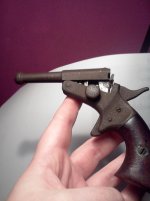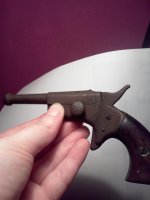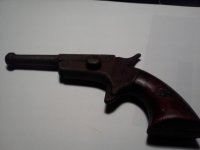Hello,
I'm from the netherlands, where guns aren't very usual and no-one seems to know anything about them, so I'm trying my luck here!
When we started to remodel our house my dad found a gun (pistol?) inside one of the bricks of our walls. All we know is that our house was built after 1850, but because it was build from salvaged bricks and material from older houses, we still can't place any date on it. (though i think it's probably not thát old?)
Anyways, any light you can shed on our mysterious finding would be much appreciated since we know literally nothing!
I have added photo's so hopefully there's someone knowledgeable out there!
I'm from the netherlands, where guns aren't very usual and no-one seems to know anything about them, so I'm trying my luck here!
When we started to remodel our house my dad found a gun (pistol?) inside one of the bricks of our walls. All we know is that our house was built after 1850, but because it was build from salvaged bricks and material from older houses, we still can't place any date on it. (though i think it's probably not thát old?)
Anyways, any light you can shed on our mysterious finding would be much appreciated since we know literally nothing!
I have added photo's so hopefully there's someone knowledgeable out there!



